Outdoor Delaware is the award-winning online magazine of the Delaware Department of Natural Resources and Environmental Control. Articles and multimedia content are produced by the DNREC Office of Communications.

Delaware has a vast variety of landscapes, from coastal waterways to forests to agricultural fields to the ever-present developments. But did you know that almost a quarter of the state is composed of wetlands?
That’s right: Around 296,000 acres of the state, about 23% of its land area, are wetlands. And that’s down from around 50% in the precolonial days.
But what is a wetland precisely, and why does it matter? Why should we care that we’re losing wetlands throughout the state?
At the simplest level, a wetland is an area where land and water meet. The U.S. Environmental Protection Agency defines it as an area “where water covers the soil, or is present either at or near the surface of the soil all year or for varying periods of time during the year, including during the growing season.”
To put it another way, perhaps you’ve driven through the salt marshes along Del. Route 1 near Smyrna. If so, you’ve passed a wetland.
And that’s just one example.
“We do like to say that unless you’re in downtown Wilmington or something, you’re probably within a mile of a wetland,” said Alison Rogerson, an environmental scientist for the Delaware Department of Natural Resources and Environmental Control’s Division of Watershed Stewardship.
Wetlands can be either freshwater or saltwater. About two-thirds to three-quarters of the wetlands in the First State are freshwater or nontidal. They can range from less than an acre to hundreds or even thousands of acres in size.

While Rogerson noted many people may think of the “iconic” salt marshes along Route 1 when wetlands come to mind, the majority of wetlands in the state are “hidden away along streams and rivers and even ponds in the middle of a forest,” she said. Swamps are a great example of wetlands, but wetlands can also sit along rivers, ponds and flats.
Almost half of the state’s wetlands are located in Sussex County, although the increased development there means they are vanishing at an alarming rate. Unsurprisingly, as the most populous county, New Castle has the fewest wetlands among Delaware’s three counties.
So, why do wetlands matter?
Well, for starters, they’re home to a variety of flora and fauna, from orchids to salamanders. They’re also nurseries for baby fish and crabs.
According to DNREC, around 90% of “recreationally and commercially important coastal fisheries rely on tidal wetlands as a place to shelter and grow their young.” Thus, they have an economic benefit.
Critically, wetlands can help prevent flooding and clean our water. They provide a key buffer that helps prevent flooding by absorbing and slowly releasing stormwater.
“We like to think of wetlands like a sponge. I’ve even heard people refer to them as like an English muffin with lots of nooks and crannies the same way a sponge is lots of little holes,” Rogerson said. “So, when your kitchen sponge is empty and you put in on a puddle, it soaks up all that water so it doesn’t run off your counter onto your floor.
“And it does have a capacity where your sponge is just full and it can’t hold any more. If you put it in a bunch of dirt or mud or something, you buried it, these little nooks and crannies wouldn’t be available to hold water anymore. So, wetlands are really the most effective when they’re clean, they haven’t been clogged up and we let them do their job and just soak up all that water.”
Wetlands, she said, are almost like “a kidney or built-in Brita filter” in their capacity to clean water.
Coastal wetlands absorb wave energy, lessening the impact as they hit our shores. A one-acre wetland can hold well over 300,000 gallons of water at a depth of 1 foot, according to DNREC. Natural, vegetated coastal wetlands are more effective than bulkhead or other hardened features in this regard.
“They really are workhorses,” Rogerson said. “They’re out there every day doing so many services for us for free that we don’t even realize.”

Unfortunately, development means many wetlands are being replaced with homes and roadways. Others, chiefly in forests, are being transformed into agricultural lands.
Around 80% of wetlands in the state are situated on private land, which “puts a huge onus on landowners to recognize, appreciate and be stewards for wetlands,” Rogerson said.
There are steps people can take to help protect wetlands: Don’t cut down too many trees, don’t mow up to the edge of a stream, don’t dump trash in wetlands, plant native rather than invasive flora, reduce fertilizer use and advocate for more regulations to help DNREC keep wetlands safe and clean.
“Things that happen miles away from a waterway, in your driveway, your gutters, that all trickles down and eventually ends up in our waterways, in a wetland and then in a waterway,” Rogerson said.
DNREC also has programs around installing rain barrels and rain gardens and being mindful of what you put down the drain. Education is a key component of protecting wetlands, and the Department has information on wetlands available at de.gov/delawarewetlands, with a variety of resources. One DNREC resource rates the health of wetlands in different watersheds. You can even view a map of wetlands and find if you have any on your property.
As Rogerson put it, wetlands “would provide so many vital services for us day and night if we would just give them some space and let them be healthy.”
Related Topics: conservation, health and science, nature, wetlands